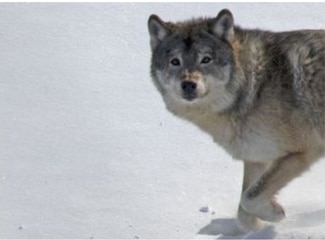This is what happens when Humans Interfere, They should have sent HIM females only to see if he could keep his own Gene-pool Alive. He obviously was a strong guy. As usual the National Park Service has some messed up views you will see when you read the entire article!
Some territorial aggression by Isle Royale’s new wolves seem to be behind 2 new wolf deaths on the island, the National Park Service says.
ISLE ROYALE, MI – He’d survived the last decade on Michigan’s most remote island against some pretty big odds. For more than 10 years, a male gray wolf known to researchers as M183 had roamed the forests and rocky outcroppings of Isle Royale in Lake Superior while nearly all the rest of his pack members died of accidents, disease or health problems caused by inbreeding.
Until recently, he and his mate – who was also his daughter and half-sister on his twisted family tree – were the last two island-born wolves to call it home. But when the National Park Service last year began an effort to relocate new wolves to Isle Royale to restore predator packs in the face of a fast-rising moose population, some scientists knew M183′s days could be numbered.
They were right. The park service announced today that two more wolves were found dead on the island this fall – killed by other wolves in what researchers are calling territorial aggression.
The remains of M183 were found in October by park staff, just before the island closed to visitors for the winter season. A month earlier, researchers monitoring the new wolves’ GPS trackers saw a female wolf’s collar was transmitting a mortality signal. They pinpointed the location and found her remains. They belonged to a wolf known as W004F, a 3-year-old that had been one of the first wolves captured for this relocation project. She had been captured near Grand Portage, Minnesota in October 2018, and released near Isle Royale’s Siskiwit Bay.
Necropsies of both animals determined the same thing: Their wounds showed they had been killed by another wolf or wolves.
“These events are not uncommon, as wolves defend and establish their territories and social hierarchy. With many wolves on the island sorting out their relationships with one another, the dynamic nature of wolf social organization, territoriality, and wolf-on-wolf aggression during group and pack formation is not unexpected,” the park service said.
“With the death of the island-born male, travel patterns of the remaining wolves are likely to change significantly, and probably dependent on whether or not the island-born female is still alive, whether she is territorial and how she gets along with the newcomers, both males and females,” said Rolf Peterson, a research professor at Michigan Technological University and long-time wolf and moose investigator on Isle Royale. “She is the final native wolf, never radio-collared, and searching for her will be a priority during the upcoming winter study.”
In all, six wolves have died and one has used an ice bridge to head back to the mainland in the 15 months since the park service began its multi-year effort to bring predator packs back to Isle Royale. Of those who died, one captured wolf died of anesthesia-related stress before she could be brought to the island, and another wolf that had been on Isle Royale for weeks died of pneumonia, park officials have said. One wolf caught in the U.P. this fall died within days of his release on the island.
These last two deaths bring the island’s wolf population down to 15: seven females and eight males. These include the last native-born female and 14 new wolves that hail from Minnesota, Michigan’s Upper Peninsula, mainland Ontario, Canada, and Michipicoten Island in northeastern Lake Superior, Ontario, Canada.
Some see M183′s death as a chance for a new angle on the plethora of data researchers are collecting. Tracking collars on the new wolves are allowing scientists to map where they are traveling on the island archipelago, which sits about 60 miles northwest of Michigan’s U.P. mainland. What they are killing and eating is also being studied. Researchers are looking at everything from bones at kill sites to piles of wolf scat.
“We have a unique opportunity to look simultaneously at the past and future of Isle Royale wolves’ genetic health. With the death of M183, we can now more fully understand how genetic isolation and inbreeding impacted the historic wolf population and use that to better monitor the new founders,” said Dr. Kristin Brzeski, a wildlife geneticist at Michigan Tech, whom the park service has partnered with to sequence the Isle Royale wolf genome for long-term monitoring of the population’s genetic health.
“This is an exciting time and we will be using cutting-edge genetic tools to track reproduction, inbreeding, and genetic change through time, hopefully providing a piece of the puzzle for maintaining a thriving Isle Royale wolf population,” she said.
Source: Isle Royale’s last native male wolf among 2 killed by new wolves – mlive.com
